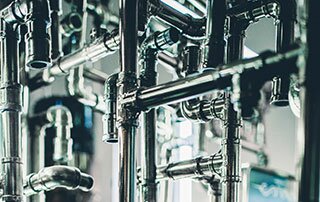In recent years, Machine Learning has become one of the most used techniques when modelling relationships between different parameters. Inspired by the successful integration of Machine Learning in many other areas, it is beginning to draw attention in the district heating sector as well. The application of Machine Learning in the context of district heating has an obvious potential as a component of tomorrows heating networks.
 Machine learning (ML) is a fast-developing tool that allows you to handle large and complex systems with many parameters and data, with different desires for efficiency. It is a branch of artificial intelligence, and defined by Computer Scientist and machine learning pioneer Tom M. Mitchell in relation to his book Machine Learning (1997) [2] as: “Machine learning is the study of computer algorithms that allow computer programs to automatically improve through experience.”
Machine learning (ML) is a fast-developing tool that allows you to handle large and complex systems with many parameters and data, with different desires for efficiency. It is a branch of artificial intelligence, and defined by Computer Scientist and machine learning pioneer Tom M. Mitchell in relation to his book Machine Learning (1997) [2] as: “Machine learning is the study of computer algorithms that allow computer programs to automatically improve through experience.”
DOWNLOAD MORE INFORMATION ABOUT MACHINE LEARNING HERE >>
Machine Learning perspectives in the context of district heating
Inspired by the successful integration of ML in many other areas, it is beginning to draw attention in the district heating (DH) sector as well. Albeit only few examples of actual application of ML in the context of DH exist today, it has an obvious potential as a component of tomorrows heating networks that can be integrated through the fast and inevitable development leading to the digitalization of the supply systems.
One of the large potentials of ML is to predict heat loads from the expanding data bases of customer data and operational data in combination with weather forecasts, national holidays, weekday, etc. to optimize and plan the heat production, thereby lowering heat loss and handling peak loads. In combination with economic data, prices of electricity, gas, etc., as well as integration of sustainable energy, which is not always reliant/constantly available, it will also be an efficient tool when integrating DH with the remaining energy sectors to optimize the overall use of resources, both environmentally and economically. This is of even higher interest, when more sustainable energy is integrated into the market, since electricity is not always needed, when the wind is blowing.
One of the large potentials of ML is to predict heat loads from the expanding data bases of customer data and operational data in combination with weather forecasts, national holidays, weekday, etc. to optimize and plan the heat production
Another large potential is to use intelligent algorithms in fault detection on the basis of retrieved customer data and other data from the network. For example, such a tool will be able to identify leakages, inefficient heating systems or errors stemming from failure related to single components. It can thus apply both at the scale of individual components and the overall installation where it can be associated with the operation and settings of the sub-station.
Based on real-time remote reading of smart meters distributed in the customer network, the software will typically be able to monitor data on the fly and significantly reduce the time passed from a fault appears to its detection and repair, which has until now been based on manual inspection.
Manual inspection is a time-demanding activity, and because of this, substations with the largest heat demand in the DH system are normally prioritized when performing the analysis, leading to a large share of poorly performing substations going unnoticed. Accumulating over the full DH network, this could have a significant effect on the energy efficiency. Identifying and correcting many small problems in a DH area can potentially help save energy and improve performance
of the production facility.
DOWNLOAD MORE INFORMATION ABOUT MACHINE LEARNING IN DISTRICT HEATING HERE >>
This report is part of RELaTED deliverable 2.4, that describes the new possibilities concerning measurement and control of ULT DH and other DH systems with high energy flexibility.
